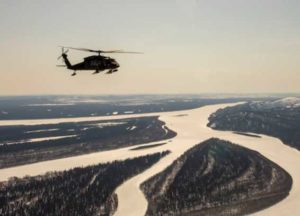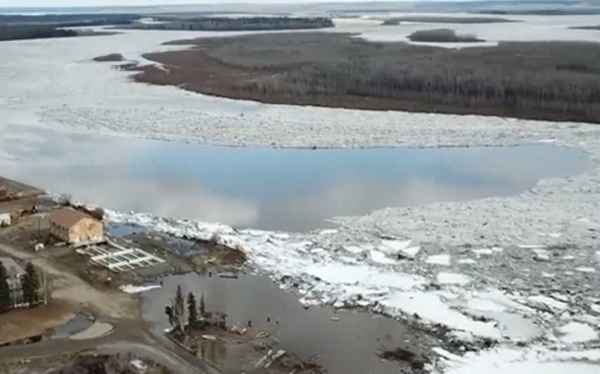Break-up flood potential above average due to high snow load, cold temperatures, and thick river ice

JOINT BASE ELMENDORF-RICHARDSON, Alaska – Due to above-average snowfall, infrequent thaw/freeze episodes, and thick, in-place ice, the ice-jam flood potential for several interior Alaskan rivers is above average this spring.
The Division of Homeland Security and Emergency Management has a long-running partnership with the National Weather Service Alaska-Pacific River Forecast Center, coordinated through the Alaska State Emergency Operations Center, to monitor ice-jam conditions and provide timely updates to riverine communities. The partnership, known as River Watch, provides updates through real-time aerial surveillance in order to issue on-scene flood advisories and warnings, assist communities with flood preparations, and support emergency response operations if flooding occurs.
“We see some type of flooding each and every spring, but conditions this year require extra preparation based on current conditions. Only time will tell where flooding occurs and how severe the inundation is, so every community should be prepared,” said Mark Roberts, SEOC River Watch incident commander. “In addition, the large amount of snow could cause spring flooding not associated with an ice jam.”
Ice-jam flooding occurs when large pieces of intact ice stop moving in the river and create a dam. These ice jams can back up water for miles and spill over the banks far inland. Deep flood waters and massive hunks of ice can flood low-lying areas and cause serious community damage.
SEOC, in coordination with the NWS Alaska-Pacific River Forecast Center, are conducting calls with at-risk riverine communities to provide the latest information on river conditions and flood risk. SEOC is also engaged in active coordination with community flood response partners including the Tanana Chiefs Conference, Yukon-Kuskokwim Health Corporation, Bethel Search and Rescue, American Red Cross of Alaska, Salvation Army, and Alaska Voluntary Organizations Active in Disaster.
The Alaska Rescue Coordination Center has been briefed on conditions and will be prepared to deploy appropriate resources in case of a flood emergency.
An Alaska Army National Guard aviation unit will be conducting its federal annual training requirements in the western region from April 30 to May 12 and will be available to provide emergency support to the River Watch effort as requested by the Rescue Coordination Center. Air crews will train with four Black Hawk helicopters based out of Bethel and three Black Hawks based out of Nome. Both locations will have hoist capable aircraft in order to support a wide range of emergency rescue scenarios.
Up-to-date river forecast information can be found at the Alaska River Forecast Center website https://www.weather.gov/aprfc/.
###[content id=”79272″]





